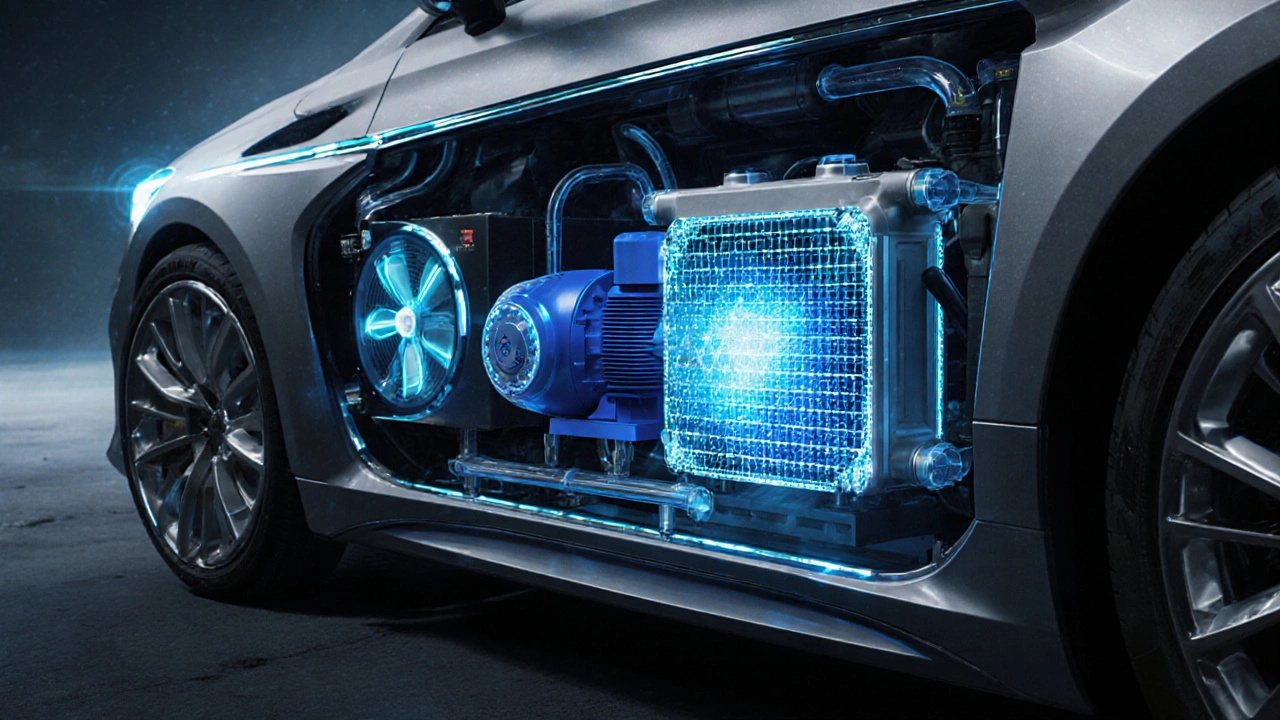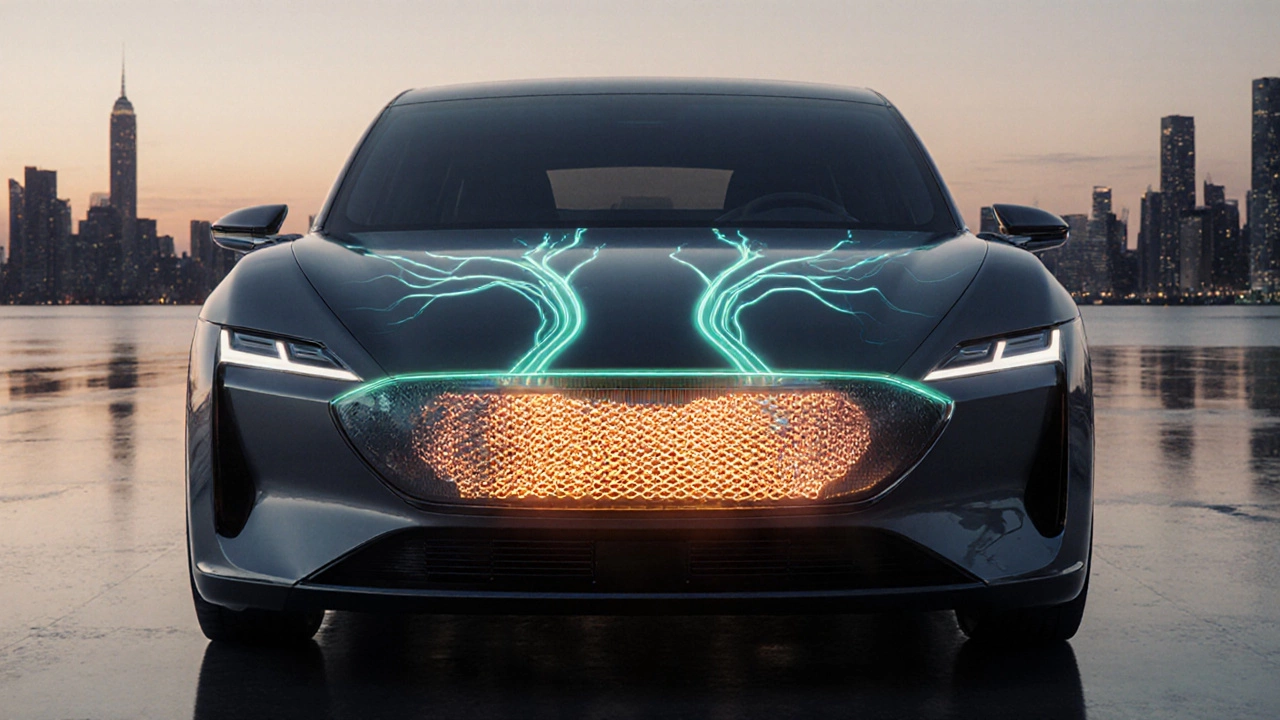Coolant Mixture Calculator
Calculate the correct ethylene glycol to water mixture for your vehicle based on your climate conditions.
Enter your climate conditions and click Calculate to see the optimal coolant mixture.
Quick Takeaways
- Most gasoline and diesel cars still rely on a traditional car radiator to keep the engine cool.
- Hybrid and electric models often replace the big radiator with compact heat exchangers and electric pumps.
- Electric water pumps give better control but don’t eliminate the need for a radiator in most ICE vehicles.
- EVs still need cooling for batteries, power electronics, and motors - they just use different hardware.
- Regular radiator maintenance remains a key part of keeping any vehicle reliable.
When you hear people ask, “Do cars have radiators anymore?”, the short answer is “yes, for most cars”. Yet the picture has changed a lot in the last decade. Modern gasoline engines still have a car radiator a heat exchanger that removes excess heat from the engine’s coolant, but the way the coolant is pumped, the fans that move air, and the auxiliary cooling for hybrids and electric vehicles (EVs) have evolved dramatically. This guide walks you through the old‑school setup, the new electronic helpers, and why an EV still needs a kind of radiator even though it never burns fuel.
How a Traditional Radiator Works
The classic cooling loop starts with the engine cooling system a closed circuit that circulates coolant to absorb heat from the engine block and head. Hot coolant leaves the engine, flows through the radiator’s thin tubes, and releases heat to the passing air. A mechanical water pump, usually driven by the serpentine belt, forces the coolant around the loop. A thermostat sits near the engine, opening when the fluid reaches about 195°F (90°C) so that the radiator can take over.
Two fans-one mechanical, one electric-draw air through the core when the car is stationary or moving slowly. The core itself is made of aluminum or copper tubes sandwiched between thin aluminum fins, maximizing surface area for heat exchange. When everything works, the temperature stays within a narrow band, protecting metal components from thermal stress.
Why Some Modern Cars Are Changing the Pump
Enter the electric water pump an electrically driven pump that replaces the belt‑driven mechanical pump. The main advantage is precise flow control. Sensors feed real‑time temperature data to the engine control unit (ECU), which can speed the pump up or slow it down instantly. This helps improve fuel economy, reduces belt wear, and lets the engine warm up faster for lower emissions.
Even with an electric pump, the radiator stays in the loop because it’s still the most efficient way to reject heat at the scale required for a 2‑liter gasoline engine. The pump’s role is just smarter, not redundant.
Radiator Fans Got Smarter, Too
Traditional engines used a viscous fan mounted on the water pump shaft. Modern cars now pair the electric water pump with one or two dedicated radiator fan a motor‑driven fan that draws air through the radiator core. These fans can be switched on or off based on exact temperature thresholds, and many have variable speeds. The result is less noise, lower parasitic load, and better cooling when the vehicle is stopped in traffic.
What About the Coolant Itself?
Coolant (often a mixture of ethylene glycol and water with corrosion inhibitors) is the medium that carries heat. Modern formulations are designed to last longer-sometimes up to 150,000 miles-so you don’t have to replace it as often. However, its boiling point and freezing point are still critical. In colder climates, a higher glycol concentration protects against freezing, while in hot climates you might opt for a lower concentration to improve heat transfer.

Do Electric Vehicles Need Radiators?
EVs don’t have a combustion engine, but they still generate a lot of heat. Battery packs, inverters, and electric motors all need thermal management. Most EVs use a heat exchanger a compact radiator‑like device that moves heat from a liquid loop to the ambient air similar in design to a traditional radiator, but the fluid loop is often separate from the drivetrain.
Because the heat load is more constant and often lower than an ICE engine, EV designers can use smaller, more efficient radiators, sometimes combined with air‑to‑air or liquid‑to‑air condensers. Some high‑performance EVs even add a second small radiator dedicated to the battery pack.
Hybrid Cars: A Mix of Both Worlds
Hybrid vehicles blend an ICE with an electric motor. They usually keep a standard radiator for the engine, plus an extra heat‑exchanger for the battery pack. In some plug‑in hybrids, the battery’s cooling loop shares the same radiator, using a dedicated inlet and outlet. This shared approach saves space but requires careful temperature management to avoid the engine’s heat affecting the battery.
When a Car Might Not Need a Traditional Radiator
There are a few niche cases where you’ll see a car without a big, front‑mounted radiator:
- Micro‑cars with tiny two‑stroke engines that rely on air‑cooling.
- Electric motorcycles that use small coolant plates or oil cooling instead of a full radiator.
- Experimental hydrogen fuel‑cell cars that use a water‑cooled heat exchanger rather than a classic radiator.
These are exceptions, not the rule for mainstream passenger vehicles.
Checklist: Is Your Radiator Still Healthy?
- Check coolant level and color every month; look for rust or oil streaks.
- Inspect the radiator fins for bends or debris that could restrict airflow.
- Listen for unusual fan noises; a failing electric fan can cause overheating at idle.
- Verify the thermostat opens at the correct temperature (often 195°F / 90°C).
- Look for leaks around the water pump, hoses, and radiator core.
If any of these items raise a red flag, schedule a service before the next long trip.

Side‑by‑Side Comparison: Traditional vs. Electrified Cooling
| Feature | Traditional (Mechanical Pump + Belt‑Driven Fan) | Electrified (Electric Pump + Variable‑Speed Fan) |
|---|---|---|
| Pump Power Source | Engine‑driven belt | 12‑V or 48‑V electric motor |
| Control Precision | Fixed speed, limited by engine RPM | Real‑time ECU command, variable flow |
| Fuel Efficiency Impact | Higher parasitic loss at low load | Lower loss; pump runs only when needed |
| Maintenance Frequency | Belt wear, pump bearing checks | Electrical connector checks, firmware updates |
| Noise Level | Mechanical hum, especially at idle | Quieter, fan speed can be modulated |
| Compatibility with EV/Hybrid | Not suitable for pure electric powertrains | Designed for hybrid and EV thermal management |
Common Misconceptions
My car is electric, so I don’t need a radiator. Wrong. Even a fully electric drivetrain generates heat that must be expelled. The hardware looks smaller, but the principle is the same.
Radiators are only for the engine. Not true. Modern cars have separate cooling loops for the transmission, AC condenser, and even the fuel pump.
Coolant is just water. It’s a carefully engineered mix. Using plain water can cause corrosion, boiling, or freezing issues.
Future Trends: Toward Integrated Thermal Management
Manufacturers are experimenting with “thermal packs” that combine battery cooling, motor cooling, and cabin heating into one compact module. Some concept cars even use phase‑change materials to store excess heat and release it later, reducing the need for a large radiator altogether. However, until those systems become mass‑produced, the classic radiator remains the backbone of vehicle cooling.
Frequently Asked Questions
Do modern gasoline cars still have a radiator?
Yes. Even with electric water pumps and smarter fans, the core function of a radiator-rejecting heat from the engine’s coolant-remains essential for almost all internal‑combustion vehicles.
Can an electric vehicle run without any radiator‑like component?
No. EVs need to keep battery packs, inverters, and motors within safe temperature limits, so they use compact heat exchangers that function like tiny radiators.
Is an electric water pump a maintenance‑free upgrade?
It reduces mechanical wear but adds electrical components that can fail. Regular checks of connectors and firmware updates are recommended.
How often should I flush my radiator coolant?
Most manufacturers suggest a flush every 5years or 60,000miles, but if you notice discoloration, a sweet smell, or overheating, do it sooner.
Why does my fan stay on after I park?
The ECU may be cooling down the engine or battery after a heavy drive. If it runs continuously for more than 10minutes, check for a stuck temperature sensor.


